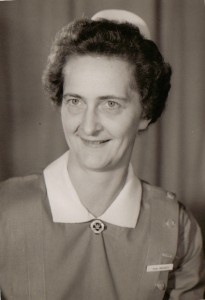Elsbeth Geiger, Director of Nursing, Hospital for Sick Children
Article from “Alumnae News”, Spring 1966

“1965 was a decision year for Schools of Nursing in Ontario. Certain definite changes were announced by the Government in mid-June and planning for these changes will have to go on during the next few years.
Due to increased demands for Nursing Services, to the increased numbers of hospital beds planned for Ontario, and to the increased usage of these beds, it was decided that the numbers of registered nurses graduated in Ontario must be doubled by 1971. This accelerated output will put a strain on existing Schools of Nursing, on clinical facilities used for practical experience, on existing numbers of nursing instructors and on the cost of nursing education. (The effect of this on Nursing Service was not mentioned!)
The proposed change in the pattern of nursing education is to a 2 + 1 year plan by 1971 and to the two year programme by 1975. Many of the nursing educators are questioning the reasoning behind these changes, and have come to the conclusion that finances dictated this pattern of change. The proposal for the 2 + 1 year plan includes a two-year educational programme during which time the theory and practice included in the Nursing course is correlated and completed and the registration exam is written. During the third year, the student is assigned to Nursing Service and she has an opportunity to perfect nursing skills. During this year she receives a salary or honorarium of $275.00 per month.
No matter how you look at this, the nurse is repaying part of the cost of her education during this third year, as she will be performing as a first level staff nurse but at a reduced salary. Registration would be granted to the nurse at the completion of the third year. After 1971, when the two year programme will be starting, the changeover could be quickly accomplished by dropping the + 1 or third year.
Confusion exists regarding the authority of the College of Nurses and the Ontario Hospital Services Commission in planning change. The College of Nurses is responsible for approving any major change planned for an existing School of Nursing or a programme for a new School of Nursing. Once this approval is secured, negotiations can proceed to finance the programmes.
The Minister of Health has planned for a 2 + 1 year nursing programme for the immediate future; yet the College of Nurses recognizes a two or three year programme, provided that certain criteria are met. Another problem confronting us is the criteria of a two year programme and the resultant difficulty that Hospital Schools will have in meeting these by 1975.
The staff of our School is presently studying curriculum content and planning curriculum changes that will meet the proposed changes that are required of us.
Later this Spring, an Affiliate Conference will be held to start specific planning for the Paediatric Nursing Programme. The problems involved here are monumental as numbers will double shortly and the quality of the experience provided at the Hospital for Sick Children must be safeguarded and motivation for specialization in paediatric nursing must be encouraged.
The implications for Nursing Service of the changes in educational patterns is only becoming evident. Little has been planned to help service personnel understand these changes and to picture what the graduate of these changed programmes can do. The need for qualified In-Service Education personnel must be recognized and steps taken to organize broad programmes to promote all phases of staff development.
It is an interesting time in the development of nursing and those of us privileged to work in Nursing Service and Nursing Education today have a responsibility to contribute to the changes that should occur during the coming decade.”
